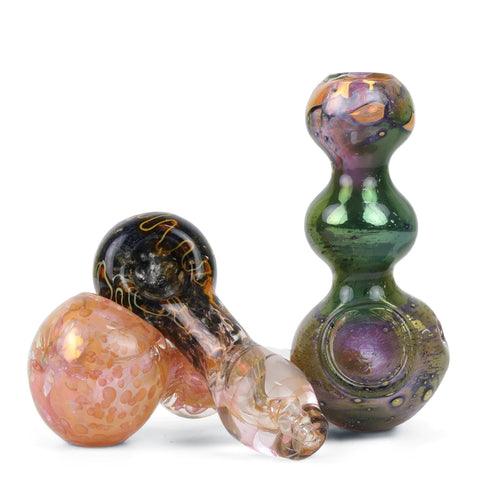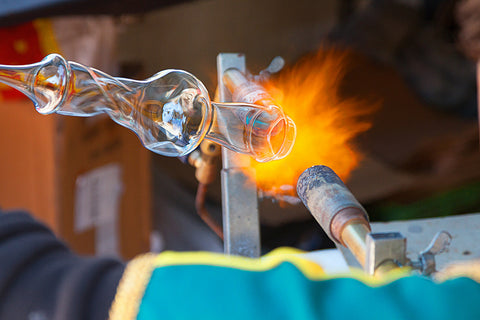Glass pipes have become a popular choice among cannabis enthusiasts for their aesthetic appeal, functionality, and smooth smoking experience. But have you ever wondered how these beautiful pieces of art are made?

Hand-Blown Pipes
Hand-blown pipes are created by skilled glassblowers who use a combination of heat, gravity, and their breath to shape the molten glass into the desired form. Hand-blown pipes are not only functional smoking devices but also works of art. Crafted by true artisans, these pipes offer a unique and personalized smoking experience.
Materials Used in Hand-Blown Pipe Making
Borosilicate Glass: Borosilicate glass, also known as "boro" glass, is a popular choice for hand-blown pipes. It is highly durable, resistant to thermal shock, and can withstand high temperatures without cracking or breaking. Borosilicate glass pipes are known for their strength and longevity.
Colored Glass: Artisans often incorporate colored glass into their designs to add vibrancy and visual appeal to the pipes. Colored glass can be used to create intricate patterns, unique textures, and stunning visual effects.
Frit: Frit is crushed glass that is often used to create intricate designs and patterns on hand-blown pipes. It can be applied to the surface of the pipe and melted in during the blowing process, resulting in beautiful and detailed designs.
The Process of Hand-Blown Pipe Making
Hand-blown pipe making is a complex and intricate process that requires skill, precision, and creativity. The process typically involves the following steps:
Gathering the Glass: The glassblower gathers a molten glass blob at the end of a blowpipe or punty. The glass is heated in a furnace until it reaches a malleable state.
Shaping the Pipe: The glassblower uses various tools, such as jacks and shears, to shape the molten glass into the desired form. They can create curves, bends, and contours to achieve the desired design.
Adding Colors and Designs: Colored glass or frit can be added to the pipe during the shaping process to create intricate patterns and designs. The glassblower carefully applies the colored glass, or frit to the surface of the pipe, and melts it in with a torch or kiln.
Blowing and Forming: The glassblower uses their breath to blow air into the pipe, expanding the molten glass and creating the desired shape. They continue to shape and manipulate the glass using tools and gravity until the pipe takes its final form.
Annealing: Once the desired shape is achieved, the pipe is placed in a kiln for a process called annealing. Annealing involves slowly cooling the glass to relieve internal stresses and ensure its durability and strength.

Lampworking
Lampworking, also known as flameworking, involves melting and manipulating glass rods or tubes with a torch. This technique allows for precise control over the shaping and design of the pipe. Lampworking is often used to create smaller, more intricate pieces.
Materials Used in Lampworking Pipe Making
Glass Rods: Glass rods are the primary material used in lampworking pipe making. These rods are made from borosilicate glass, which is highly resistant to thermal shock and can withstand high temperatures without cracking or breaking. Borosilicate glass rods come in a variety of colors, allowing artisans to create vibrant and visually appealing designs.
Glass Tubes: Glass tubes are another essential material used in lampworking pipe making. These tubes can be used to create the body of the pipe, providing a hollow space for the smoke to flow through. Glass tubes are available in different sizes and thicknesses, allowing artisans to create pipes of various shapes and sizes.
Tools: Lampworking requires the use of various tools to shape and manipulate the glass. Some common tools used in lampworking pipe making include tweezers, marvers, graphite paddles, and tungsten picks. These tools help artisans achieve precise shapes, contours, and details in their pipe designs
The Process of Lampworking Pipe Making
Lampworking pipe making involves several intricate steps that require skill and precision. The process typically includes the following:
Preparing the Glass: The lampworking process begins by heating the glass rods or tubes using a torch flame. The glass is heated until it becomes soft and malleable, ready to be shaped and manipulated.
Shaping and Manipulating the Glass: Using various tools, the glassblower shapes and manipulates the molten glass to create the desired form of the pipe. They can create curves, bends, and contours, allowing for intricate and unique designs. The glassblower carefully controls the heat and the movement of the glass to achieve the desired shape and details.
Adding Colors and Patterns: During the shaping process, the glassblower can incorporate colored glass rods, or frit to create intricate patterns and designs. The colored glass is melted into the surface of the pipe, resulting in vibrant and visually appealing designs. This step allows for endless possibilities in creating visually stunning lampworking pipes.
Annealing: Once the desired shape and design are achieved, the pipe is placed in a kiln for a process called annealing. Annealing involves slowly cooling the glass to relieve internal stresses and ensure its durability and strength. This step is crucial to prevent the pipe from cracking or breaking due to thermal stress.

Picking the Right Pipe
Picking the right piece is important. It’s an essential tool for smoking flower, and for some, an extension of their personal style and aesthetic tastes.
Size and Portability: Consider whether you prefer a smaller, more portable pipe or a larger, more intricate piece. Smaller pipes are convenient for on-the-go use, and can be more durable, while larger pipes can offer a more substantial smoking experience.
Design: Glass pipes come in a wide range of designs, colors, and patterns. Choose a pipe that resonates with your personal style and preferences, as well as the environment.
Functionality: Consider how the pipe feels in your hand and how easy it is to use, and clean. Ensure that the pipe has a comfortable grip, and the bowl size suits your smoking preferences.
Budget: Glass pipes can vary in price depending on factors such as size, complexity of design, and the reputation of the artist. Set a budget that aligns with your preferences and explore options within that range.

Find Your Glass (and Fill it Up) at CBD Kratom
Embrace the artistry and functionality of glass pipes as you embark on your smoking journey. Stop by one of our 60+ locations to find your perfect glass piece, and some flower to fill it. Or find all of your smoking options here on our site.

